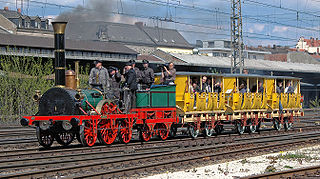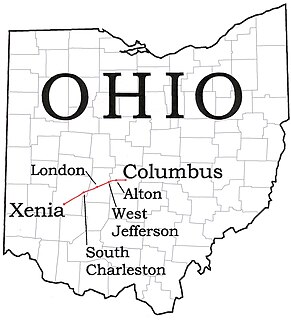
The Galena and Chicago Union Railroad (G&CU) was a railroad running west from Chicago to Freeport, Illinois, never reaching Galena, Illinois. A later route went to Clinton, Iowa. Incorporated in 1836, the G&CU became the first railroad built out from Chicago.

Vulcan Iron Works was the name of several iron foundries in both England and the United States during the Industrial Revolution and, in one case, lasting until the mid-20th century. Vulcan, the Roman god of fire and smithery, was a popular namesake for these foundries.

A Crampton locomotive is a type of steam locomotive designed by Thomas Russell Crampton and built by various firms from 1846. The main British builders were Tulk and Ley and Robert Stephenson and Company.

Under the Whyte notation for the classification of steam locomotives, 2-2-2 represents the wheel arrangement of two leading wheels on one axle, two powered driving wheels on one axle, and two trailing wheels on one axle. The wheel arrangement both provided more stability and enabled a larger firebox than the earlier 0-2-2 and 2-2-0 types. This configuration was introduced in 1834 on Robert Stephenson's 'Patentee locomotive' but it was later popularly named Jenny Lind, after the Jenny Lind locomotive which in turn was named after the popular singer. They were also sometimes described as Singles, although this name could be used to describe any kind of locomotive with a single pair of driving wheels.
Tulk and Ley was a 19th-century iron mining company in west Cumberland which also ran an engineering works at Lowca near Whitehaven.

The Pacific Mail Steamship Company was founded April 18, 1848, as a joint stock company under the laws of the State of New York by a group of New York City merchants. Incorporators included William H. Aspinwall, Edwin Bartlett, Henry Chauncey, Mr. Alsop, G.G. Howland and S.S. Howland.
The Chester and Holyhead Railway was an early railway company conceived to improve transmission of Government dispatches between London and Ireland, as well as ordinary railway objectives. Its construction was hugely expensive, chiefly due to the cost of building the Britannia Tubular Bridge over the Menai Strait. The company had relied on Government support in facilitating the ferry service, and this proved to be uncertain. The company opened its main line throughout in 1850. It relied on the co-operation of other railways to reach London and in 1859 it was absorbed by the London and North Western Railway.

Bury, Curtis and Kennedy was a steam locomotive manufacturer in Liverpool, England.

The Columbus and Xenia Railroad was a railroad which connected the city of Columbus, with the town of Xenia in the state of Ohio in the United States. Construction began in October 1847, and the line opened in February 1850. Connecting with the Little Miami Railroad, it created the first rail route from Cincinnati to Columbus.

The Cleveland, Columbus and Cincinnati Railroad (CC&C) was a railroad that ran from Cleveland to Columbus in the U.S. state of Ohio in the United States. Chartered in 1836, it was moribund for the first 10 years of its existence. Its charter was revived and amended in 1845, and construction on the line began in November 1847. Construction was completed and the line opened for regular business in February 1851. The CC&C absorbed a small bankrupt railroad in 1861, and in May 1868 merged with the Bellefontaine Railway to form the Cleveland, Columbus, Cincinnati and Indianapolis Railway.
George Forrester and Company was a British marine engine and locomotive manufacturer at Vauxhall Foundry in Liverpool, established by Scottish engineer George Forrester. The company opened in 1827 as iron founders and commenced building steam locomotives in 1834.

Fire Queen is an early steam locomotive built by A. Horlock and Co in 1848 for the Padarn Railway. It is the only surviving locomotive from that railway, and it is preserved at the Penrhyn Castle Railway Museum.

The Cleveland, Painesville and Ashtabula Railroad (CP&A), also known informally as the Cleveland and Erie Railroad, the Cleveland and Buffalo Railroad, and the Lake Shore Railroad, was a railway which ran from Cleveland, Ohio, to the Ohio-Pennsylvania border. Founded in 1848, the line opened in 1852. The railroad completed the rail link between Buffalo, New York, and Chicago, Illinois.

James Matthews was a prominent 19th century architect in northern Scotland who also served as Lord Provost of Aberdeen from 1883 to 1886 during which time he enacted an important city improvement plan. His work as an architect is largely in the Scots baronial style.
Water Witch was an early British wood-hulled paddle steamer, built in 1835 at Harwich, England for steam packet services from Dover to London and to Boulogne. A successful fast ship, she was later operated on services on the South Coast of England and in the Bristol Channel
Solomon Cook was an American engineer who constructed a substantial mill and one of Western Australia’s first steam engines at York.













